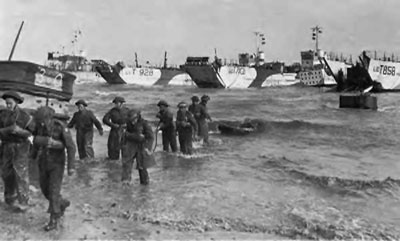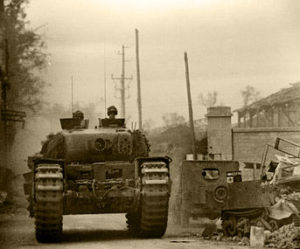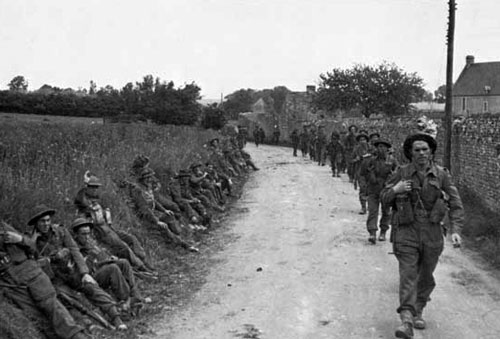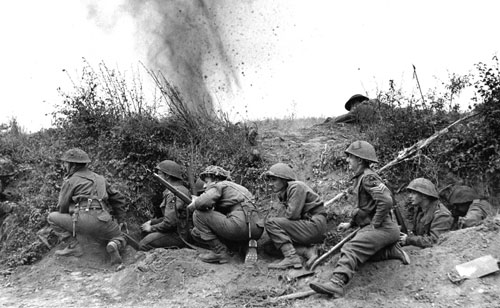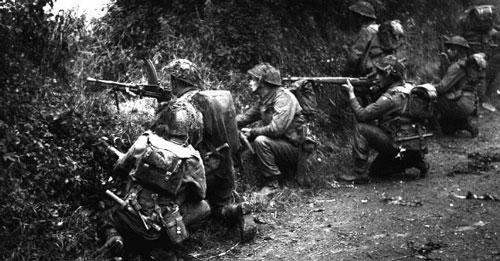with Andy Parkes and Wayne Turner
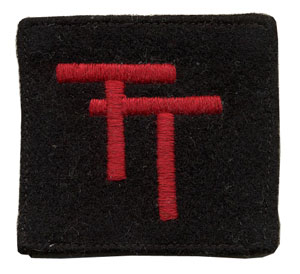
In 1939 the 50th Division was organised as a Motor Division and served in France in 1940, taking part in the evacuation at Dunkirk. After escaping, it was re-organised as a Infantry Division in Britain. It was sent on 22 April 1941 to North Africa and was reinforced by the 69 Brigade from the disbanded 23rd ‘Northumbrian’ Division
North Africa and Sicily
The division saw service in the Desert Campaign, where it lost the 150 Brigade at Gazala. Under-strength, it took part in the retreat to El Alamein, acting in reserve. During the 2nd Battle of El Alamein it was positioned in the south. It was reinforced with the 1st Free French Brigade and 1st Greek Brigade for its planned attack on the Italian Folgore (Airborne) Division. It was supported by elements of the British 7th Armoured Division. Later in the battle it was transferred north to take part in Operation Supercharge.
In Tunisia the 50th Division assaulted the Wadi Akrit position, and was then involved in the Sicily landings of 1943, where it landed at Avola.
The 168 Brigade was attached from the 56th Division during the campaign.
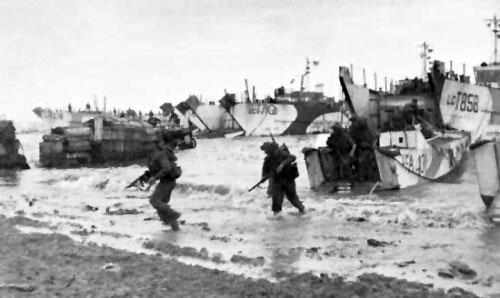
In October 1943 the division was withdrawn to Britain for reforming and training before landing on D-Day. The 231 Brigade (an independent unit formed from regular troops stationed on Malta) were permanently attached, and the 56 Brigade was temporarily attached for the initial beach assault. Later the 56 Brigade was transferred to the 49th ‘West Riding’ Division.
D-Day
For D-Day the 50th Division was given the beach code named “GOLD” to land on. It covered an 8km area between la Riviére in the west to Le Hamel in the East. The German defences in this area were manned by the 4th Company 441. Ost Battalion (4/441 Ost) and 7/736 Grenadier Regiment belonging to the 716. Infanteriedivision, which were located on the east flank, and I Battalion/916. Grenadier Regiment of the 352. Infanteriedivision. Manning the marshy area between these two formations were elements of the 3/441Ost. Weapons in this area were 5cm PaK38 guns in open concrete emplacements and 7.5cm guns mounted within pill boxes.
To the rear were several artillery batteries covering the beach area (Mont Fleury, Creully, Crépon, Ryes and Marefontaine farm).
The role of the 50th Division was to establish a beachhead between Arromanches-les-Bains and Ver-Sur-Mer, then head towards Route Nationale 13 (RN13) linking Bayeux to Caen.
The first wave was made up of the 231 and 69 Brigades; once the assault was complete, the follow-up formations of 56 and 151 brigades would push inland towards RN13 supported by tanks of the 8 Armoured Brigade.
The assault started at 07.25 hrs on the “King” sector of Gold beach, almost an hour late. The Green Howards, came ashore supported by DD tanks of the 4th/7th Royal Dragoon Guards. Following a massive bombardment from HMS Warspite and HMS Ramilles, the assault came in from a distance of seven miles out, unlike the Americans who had deployed from twelve miles out. The DD tanks were not deployed out at sea, but they were landed directly on to the beaches. This meant that the assaulting troops had armour supporting them directly on the beaches.
The 8 Armoured Brigade supported the 69 Brigade with the 4th/7th Royal Dragoon Guards on the right flank directed on Riviére, and on the left the Sherwood Rangers Yeomanry supported the 231 Brigade at Le Hamel. The 24th Lancers were held in reserve to be landed later in the afternoon, but due to bad weather and congestion they did not land until 7 June.
Due to the shelved nature of the beach, the landing craft grounded early and the troops had to wade ashore. The defences in this area were weak and the troops easily subdued the defenders. They then pushed on inland to silence the gun batteries behind.
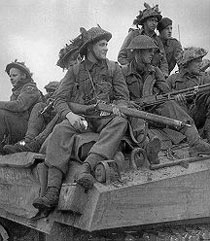
The battle for Le Hamel ground to a halt and casualties mounted, but direct support by the 147th Field Regiment, Royal Artillery (2nd Army) helped to reduce the strongpoint and it was finally taken at 16.00 hours.
By the end of the day nearly all of the 50th Division’s objectives had been captured. In the east contact was made with the Canadians South of Tierceville. The 69, 56 and 151 Brigades dug in on a line from Vaux-sur-Aure to Coloumbs. The 56 Brigade completed the day one mile short of Bayeux, 151 Brigade group reached the Caen-Bayeux road and the 69 Brigade had linked up with the Canadians and advanced a massive eight miles inland. The 7th Battalion, Green Howards had advanced so far they had to be pulled back to Coloumbs. Patrols from the 2nd Gloucester’s had reached the outskirts of Bayeux.
To the west, Arromanches was reached at 2000 hours and reported clear of enemy an hour later.
The men of the 47 Royal Marine Commando dug in on Hill 72 south of the Longues-Sur-Mer battery; their objective of the Port en Bessin would not fall until the 8 June, after serious heavy fighting.
Fighting Inland
The next day the bridgehead was enlarged, St Leger was captured and the leading elements of the Sherwood Rangers entered Bayeux to a warm reception.
8 June saw the 8 Armoured Brigade form a mobile column consisting of the 61 Recce Regiment, 1st Dorsets, 288 Anti-tank Regiment, RA, plus A Company of the Cheshire Regiment. An advance was ordered on a two-axis front with the 61 Recce Regiment on the right and 24th Lancers on the left.
On 7 June the 6th Green Howards had been ordered to advance and by 10.00 hours had passed through Rucqueville en-route for Ducy-Ste-Marguerite. Meanwhile the 7th Battalion Green Howards had begun an assault on the wireless station west of the Coloumbs-Loucelles road. The attack, conducted by the A and C Companies with B Company in support, was a complete success and resulted in 50-60 prisoners being taken. Both battalions then dug in and started receiving reinforcements and conducting fighting patrols in the area until 11 June when, the advance began again.
9 June saw A company 1st Dorsets, with 4/7 Dragoon Guards in support, moving through Audrieu south of the Caen rail line, while the Sherwood Rangers moved west around Audrieu to find an open flank. As the 8th Durham Light Infantry (DLI) became available, they were attached to the Sherwood Rangers and moved towards Point 103 mounted on the tanks. By 13.00 hours they were firmly ensconced on Point 103 and the 24th Lancers and 147th Field Regiment, RA were ordered to move up.
An attack was ordered on St Pierre for 17.30 hours using the 8th DLI and 4/7 Dragoon Guards, supported by self-propelled guns of 147th Field Regiment and machine-guns of the 5th Cheshires. A captured POW reported that St Pierre (1km east of Tilly-sur-Seulles) was lightly held, but it was found later that this was incorrect. It was finally cleared of enemy by 19.00 hours. By the evening of 9 June St Pierre was held and the 1st Dorsets along with the 4/7 Dragoon Guards were on Point 103.
10 June saw the 8th DLI being attacked by elements of Panzer Lehr Panzerdivision to try to clear the British from St Pierre.
Attacks were also directed to clear Point 103 from the west. By the afternoon all attacks had been beaten off with heavy casualties to the Germans (2 Tigers, 4 Panzer IVs, and 3 75mm SPs). In the evening an American liason officer arrived and gave the 50th Division access to a 155mm Artillery Regiment allowing targets to be engaged outside the range of 147th Field Regiment’s guns.
On 11 June an attack on Cristot to the East of Point 103 using 69 Brigade was planned against elements of 12. SS-Panzerdivision. The 7th Green Howards were to advance on the left flank to secure Brouay and make contact with the Canadians at Putot-En-Bessin. Meanwhile 6th Green Howards were to attack Cristot with support from 4/7th Dragoon Guards and 147th Field Regiment. The attack failed to capture its objective and stalled one field short of Cristot and the attack on Brouay failed to penetrate the defensive positions.
On 12 June further attacks were planned to extend the bridgehead, an attack on the Tessel-Bretteville feature was organised and carried out in the morning. It was to be a two-part attack with the first objective the high ground overlooking La Caude Rus, and the second part the Juvigny to Fontenay-Le-Pessel road. The first objective was captured, but further progress was stalled by Tigers and Panthers in the woods around Point 102. Meanwhile the 69 Brigade had tried to clear the woods between Cristot and St Pierre, but suffered heavy casualties.
Orders were then received for the 50th Division to hold the line from Point 103 to La-Belle-Epine, the 8th DLI were pulled back from St Pierre and the Sherwood Rangers were ordered to cover the withdrawal.
This left the 69 Brigade holding Point 103 with the 5th East Yorks in support, while the 146 Brigade (49th ‘West Riding’ Division) held the Loucelles road.
Tilly-sur-Seulles
With its infantry brigade still waiting to land, 22 Armoured Brigade of the 7th Armoured Division was sent forward to assist the 50th ‘Tyne and Tees’ Division in taking Tilly-sur-Suelles. The mission was to follow the 50th Division’s 56 Brigade and, once they had opened a hole in the line, to exploit it all the way to Villers-Bocage and then press on to Evrecy, deep in the German rear.
On 11 June the 50th Division attacked in the area of Tilly-sur-Seulles, Juvigny, Hottot-les-Bagues, and la Senaudiere, only to find the newly arrived Panzer Lehr Division also attacking head on into the same area. As the forces clashed the 7th Armoured Division moved forward in support. Even with their support, the attack stalled well short of its intended line.
After another attack on St Pierre on the evening of 11 June the town was abandoned. The 8 Armoured Brigade withdrew to rest and refit and their positions were taken over by the 49th Division, which allowed the 50th Division to concentrate on Tilly-sur-Seulles.
On 14 June they launched an attack led by the 151 and 231 Brigades supported by the 4/7 Dragoon Guards. The objectives were the villages of Lingévres and Verriéres. The 6th DLI took Verriéres and pushed south towards Hottot-les-Bagues. Once more they faced the Panzer Lehr’s Panzergrenadiers through the difficult bocage country, where the defenders were always at an advantage. The attack was supported by heavy air and artillery support. The 9th DLI advanced towards Lingévres. They soon came under fire from a large wood astride of their axis of advance. Heavy casualties were taken, but they were finally were able to advance through the wood into the village. The village was taken and defensive positions were organised against German counter-attacks. The inevitable counter-attack arrived and quickly knocked out four 6 pdrs, but the supporting 4/7 Dragoon Guards were more successful, knocking out six Panthers. The Germans attacked again at 1615 hours from the west. Three more Panthers were knocked out by the DLI anti-tank gunners.
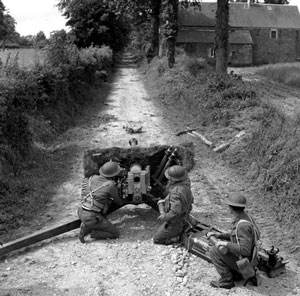
The following day the attack was taken over by the 56 Brigade, who completed the capture of Tilly-sur-Seulles. On 15 June the 231 Brigade took Hottot-les-Bagues with the 1st Hampshires. A German counter-attack supported by tanks ejected them from their prize, and another attack was arranged with the 2nd Devonshires leading. The village was once again held by evening, but the brigade command withdrew the battalion as the hold on the village was not secure. This allowed the Germans to attack Tilly-sur-Seulles and re-occupy it. The town was finally taken on 17 June. In the meantime the 50th Division became bogged down, and little further progress was made for the rest of June.
Another push to take Hottot-les-Bagues was launched on 9 July, but was pushed back by the Germans. Another attack was arranged by 11 July to be carried out by the 231 Brigade supported by the Sherwood Rangers. It was supported by a massive rolling barrage. Progress was made, but the village was not taken. It wasn’t until 19 July, after the Germans had withdrawn across the whole division front, that the village was finally securely in British hands.
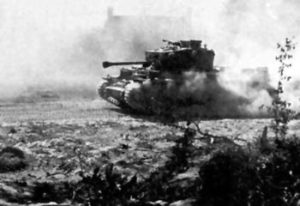
The next major action of the 50th Division was in August during Operation Bluecoat. XXX Corps (7th Armoured, 43rd and 50th Divisions) objectives were Villers-Bocage, Aunay-sur-Odon and finally Mont Pincon. The operation began on 30 July and initially progress was slow. The 50th Division was held up at Amaye-sur-Seulles.
The British pushed the front line back by 13km (eight miles), seized the German dominated high ground south of Caen and drove a wedge between the German Seventh Army and Panzer Group West. Mont Pincon was finally taken by the 43rd ‘Wessex’ Division on 6 August.
The operation was not strategically vital in itself, but it facilitated the US advance by concentrating the increasingly depleted German forces on the Caen area.
After France
The 50th Division was considered to have performed well in Normandy; in fact, out of the three divisions that were veterans of the desert (the others being 7th Armoured Division and 51st Highland) it performed the best. It was one of the driving forces behind the British advance. However, it was exhausted by the end of the battle.
It later played a minor role in Operation Market Garden, where the 231 Brigade was detached to help support the advance of Guards Armoured. The division stayed in northwest Europe until December 1944, when it was again returned to Britain, this time for the remainder of the war, and was converted into a training division. At the end of the war, it was sent to Norway and converted into British Ground Forces, Norway.

